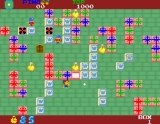
Toy Pop
Encyclopedia
is a multi-directional shooter arcade game
that was released by Namco
in 1986. The game was included in Namco Museum Vol.1
.
The back story is that two dolls, Pino and Acha, have gone into the castle of the witch Majyo, who has kidnapped their friends. The game's opening cutscene reads "PINO AND ACHA ARE GOING TO MAJYO'S CASTLE TO SAVE FRIEND" before gameplay begins. The story culminates with a battle against Majyo in the 44th level.
Stationery bearing Toypop artwork was also created. Two known designs that were featured include one that was a reproduction of the game's opening cutscene, and the other being artwork of the game's several characters grouped together.
Arcade game
An arcade game is a coin-operated entertainment machine, usually installed in public businesses such as restaurants, bars, and amusement arcades. Most arcade games are video games, pinball machines, electro-mechanical games, redemption games, and merchandisers...
that was released by Namco
Namco
is a Japanese corporation best known as a former video game developer and publisher. Following a merger with Bandai in September 2005, the two companies' game production assets were spun off into Namco Bandai Games on March 31, 2006. Namco Ltd. was re-established to continue domestic operation of...
in 1986. The game was included in Namco Museum Vol.1
Namco Museum
Namco Museum refers to the series of video game compilations released by Namco for various 32-bit and above consoles, containing releases of their games from the 1980s and early 1990s...
.
Description
Toy Pop is a top-down multi-directional shooter that can be played both single-player or with two players simultaneously. The player ventures through 44 levels (Toy Pop uses the toy-themed term "Box" instead of "Level" to fit with the game's setting) collecting four gold hearts contained in jars in each level in order to advance. Along the way, the player must open gift-wrapped containers concealing weapons and score-increasing bonus items; these various weapons are used to defeat several different varieties of enemies, with many typically vulnerable to only one type of weapon.The back story is that two dolls, Pino and Acha, have gone into the castle of the witch Majyo, who has kidnapped their friends. The game's opening cutscene reads "PINO AND ACHA ARE GOING TO MAJYO'S CASTLE TO SAVE FRIEND" before gameplay begins. The story culminates with a battle against Majyo in the 44th level.
Merchandising and promotion
To promote Toy Pop's 1986 release, Namco distributed yellow flyers to Japanese arcade establishments. These fliers presented information regarding the game, such as the rules of the game, pictures of the in-game enemies, and a single full-colored screenshot of Toy Pop's gameplay in the middle of the page. This flier also included retail information such as the Toy Pop arcade machine's ¥93000 price.Stationery bearing Toypop artwork was also created. Two known designs that were featured include one that was a reproduction of the game's opening cutscene, and the other being artwork of the game's several characters grouped together.

